Despite the glistening Christmas lights and festive atmosphere, if exploring our coastline is a highlight of your year, you might want to leave this page open in the vicinity of your nearest and dearest. They just might pick up the not-so-subtle hint.
Series two of the Great Lighthouses of Ireland has returned to our screens, airing on Sunday evenings at 6:30pm on RTÉ One. It’s over four years since series one aired and over six years since the idea was first raised with CEO of Irish Lights, Yvonne Shields O’Connor. In that time, producer and author David Hare gathered a substantial record of the lighthouses of Ireland.
Usually kept busy producing cookery programmes with Neven Maguire and Rory O’Connell, every now and then David likes to work on something different. When the idea for The Great Lighthouses of Ireland came about, David admits: “I thought this is too good of an idea, it must have been done before. So, the first thing I did was check and, lo and behold, there had not been a series on Irish lights since the mid-1900s and it had been a British series.”
In putting the book together, David focused on depth of detail rather than a geographical list of Irish lighthouses. As the name suggests, it is a focus on the great lighthouses of our island. In doing so, there is something for everyone; for the historian, the engineering buff, the wildlife enthusiast or students of architecture or the sciences. As David adds: “I had in mind when I wrote the book, my own son … I wanted him to look at it and say oh that would be a great book for dad.”
With an intention to create a permanent record, decisions had to be made to make sure as many worthy stories were featured. An event such as the tragic Fastnet race of 1979 is not in the book as this has been told very well in episode one of series two. Room needed to be made for other stories of merit such as Ireland’s first – and last – nuclear-powered lighthouse off the Donegal coast.
A Gracious Lady
Other stories that caught the author’s attention include that of Pauline Butler. Pauline was the mother of Gerry Butler who was the lighthouse keeper during the Fastnet race of ’79. She was the daughter of a lighthouse keeper and she married a lighthouse keeper. She had 15 children, two of whom became lighthouse keepers and when her husband died, Irish Lights appointed Pauline as full-time attendant of Galley Head lighthouse on Cork’s south coast.
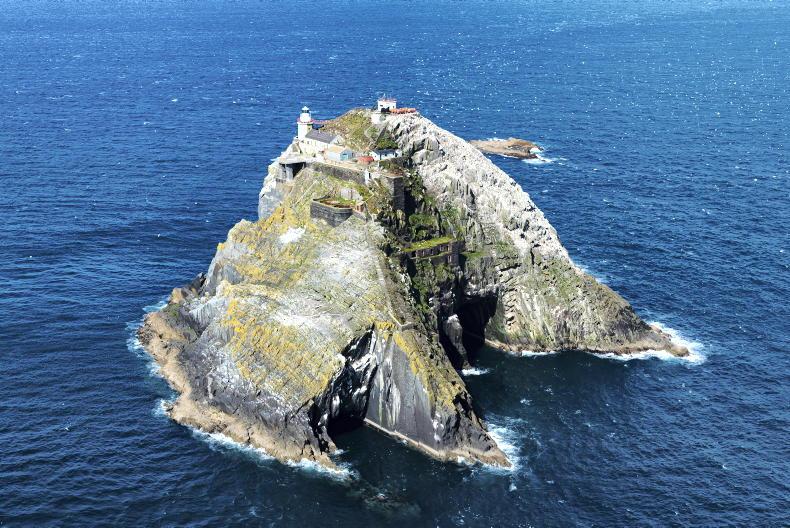
Bull Rock lighthouse, off the Beara Peninsula, Co Cork
While women had been recognised for their important role in the Irish Lights family over the years, Pauline was unusual in that she was officially recognised; she had the uniform and the title of attendant. Her life is greatly summarized here but to read in detail her fascinating early years and the moving story behind her marriage to Larry, makes this author wonder why have we not been told the story of women such as Pauline before now?
You may be captivated by the romantic nature of lighthouses and, if so, you are not alone. The book records Pauline as saying of her time in Galley Head after her husband died: “Even when it’s blowing a gale … it has its own magic and romanticism. My gracious old lady keeping a watchful eye on me, five blinks every twenty seconds.”
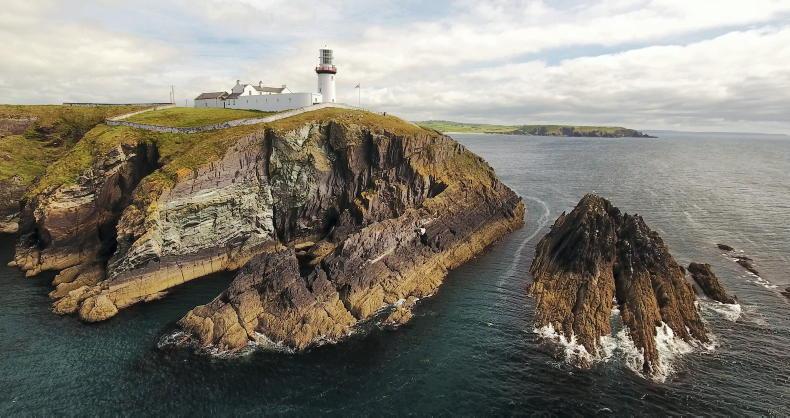
Galley Head lighthouse, Co Cork, taken by drone from the westerly side
Another vital role the book highlights is that of the lightships and their keepers. Stationed not on a rock, but on a boat for four weeks at a time, it is acknowledged the conditions for lightship keepers were far harder than that of a lighthouse keeper. The purpose of lightships was to warn ships of potential danger such as sandbanks and rocks. Not only adjusting to cramped working conditions, the lightship keepers had to deal with constant motion and relentless damp while onboard.
The rescue of the Daunt Rock lightship off the coast of Cork, between Cork harbour and Kinsale in 1936, is well known in sea-faring circles. A savage storm blew up and broke the Daunt Rock lightship, the Comet, from her moorings with eight crew on board. Lightships did not have any means of propulsion so it was drifting, causing real danger to other ships in the area. With a dramatic painting by Tim Thompson illustrating the stomach-churning rescue by Ballycotton lifeboat crew, led by coxswain Patrick Sliney, Hare details the dreadful conditions the crew overcame in an effort to save the lives of the keepers onboard. A rescue that is considered to be one of the most extraordinary in the Royal National Lifeboat Institution’s (RNLI’s) history.
The dramatic setting of lighthouses has captured the imagination of many artists. Off the northwest coast, Tory Island lighthouse is one of 11 lighthouses giving guidance to vessels passing through Donegal’s waters. Mention Tory Island to visitors and most likely the ‘King of Tory’ and Derek Hill will be brought up. Hill, an English artist settled in Co Donegal, discovered a hut close to the lighthouse on a visit to the island in the 1950s. Detailing how Hill became associated with Tory Island, this book includes the beginnings of the Tory School of Primitive Painting, including a connection to one of the ‘Kings’ of Tory, Patsy Dan Mac Ruaidhrí.
Beaufort Wind Scale
Taking a look at weather systems, The Great Lighthouses of Ireland explains how Ireland has been “at the forefront of mapping the seabed” and not just in recent times. For anyone with an interest in watersports or understanding our weather, the Beaufort Wind Scale will be a familiar feature in training manuals and communicating with colleagues. Reading about Francis Beaufort’s early life in Ireland and slow but sure rise through the naval ranks to becoming chief hydrographer of the admiralty at the age of 55 is added to all the more by seeing Admiral Beaufort’s hand-written “Scale of Wind”, including the succinct description of Force 12 as “…Hurricane”.
Gathering together the records of people who have contributed to making Irish waters a safer place to be, The Great Lighthouses of Ireland is far more substantial than a good-looking coffee table book. With insights into the organisation of Irish Lights, describing day-to-day life on a rock and the position these great lighthouses found themselves in through the wars that have occurred, the author, David Hare, describes working on this project as “a joy”, and to read this book is also a joy.
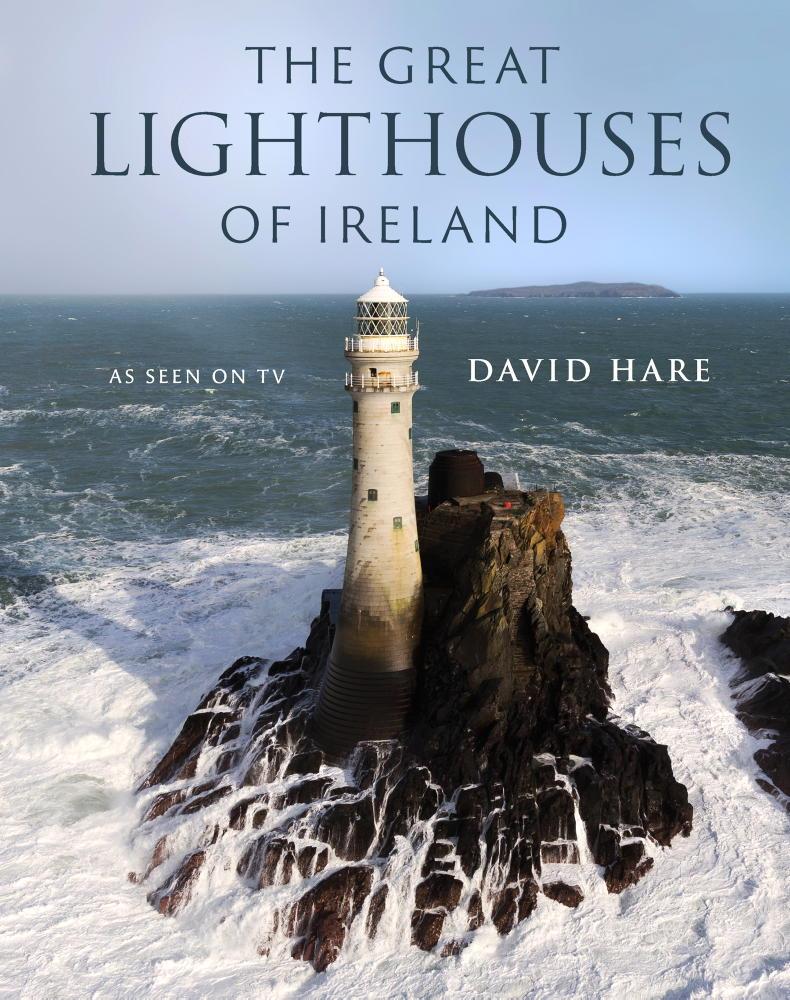
The Great Lighthouses of Ireland (hardback), published by Gill is available in all good bookshops. Retailing at €27.99
Read more
Lights, camera, action: behind the scenes on Ros na Rún
Margaret Leahy: bus 424 has been a game changer for my rural life
Despite the glistening Christmas lights and festive atmosphere, if exploring our coastline is a highlight of your year, you might want to leave this page open in the vicinity of your nearest and dearest. They just might pick up the not-so-subtle hint.
Series two of the Great Lighthouses of Ireland has returned to our screens, airing on Sunday evenings at 6:30pm on RTÉ One. It’s over four years since series one aired and over six years since the idea was first raised with CEO of Irish Lights, Yvonne Shields O’Connor. In that time, producer and author David Hare gathered a substantial record of the lighthouses of Ireland.
Usually kept busy producing cookery programmes with Neven Maguire and Rory O’Connell, every now and then David likes to work on something different. When the idea for The Great Lighthouses of Ireland came about, David admits: “I thought this is too good of an idea, it must have been done before. So, the first thing I did was check and, lo and behold, there had not been a series on Irish lights since the mid-1900s and it had been a British series.”
In putting the book together, David focused on depth of detail rather than a geographical list of Irish lighthouses. As the name suggests, it is a focus on the great lighthouses of our island. In doing so, there is something for everyone; for the historian, the engineering buff, the wildlife enthusiast or students of architecture or the sciences. As David adds: “I had in mind when I wrote the book, my own son … I wanted him to look at it and say oh that would be a great book for dad.”
With an intention to create a permanent record, decisions had to be made to make sure as many worthy stories were featured. An event such as the tragic Fastnet race of 1979 is not in the book as this has been told very well in episode one of series two. Room needed to be made for other stories of merit such as Ireland’s first – and last – nuclear-powered lighthouse off the Donegal coast.
A Gracious Lady
Other stories that caught the author’s attention include that of Pauline Butler. Pauline was the mother of Gerry Butler who was the lighthouse keeper during the Fastnet race of ’79. She was the daughter of a lighthouse keeper and she married a lighthouse keeper. She had 15 children, two of whom became lighthouse keepers and when her husband died, Irish Lights appointed Pauline as full-time attendant of Galley Head lighthouse on Cork’s south coast.

Bull Rock lighthouse, off the Beara Peninsula, Co Cork
While women had been recognised for their important role in the Irish Lights family over the years, Pauline was unusual in that she was officially recognised; she had the uniform and the title of attendant. Her life is greatly summarized here but to read in detail her fascinating early years and the moving story behind her marriage to Larry, makes this author wonder why have we not been told the story of women such as Pauline before now?
You may be captivated by the romantic nature of lighthouses and, if so, you are not alone. The book records Pauline as saying of her time in Galley Head after her husband died: “Even when it’s blowing a gale … it has its own magic and romanticism. My gracious old lady keeping a watchful eye on me, five blinks every twenty seconds.”

Galley Head lighthouse, Co Cork, taken by drone from the westerly side
Another vital role the book highlights is that of the lightships and their keepers. Stationed not on a rock, but on a boat for four weeks at a time, it is acknowledged the conditions for lightship keepers were far harder than that of a lighthouse keeper. The purpose of lightships was to warn ships of potential danger such as sandbanks and rocks. Not only adjusting to cramped working conditions, the lightship keepers had to deal with constant motion and relentless damp while onboard.
The rescue of the Daunt Rock lightship off the coast of Cork, between Cork harbour and Kinsale in 1936, is well known in sea-faring circles. A savage storm blew up and broke the Daunt Rock lightship, the Comet, from her moorings with eight crew on board. Lightships did not have any means of propulsion so it was drifting, causing real danger to other ships in the area. With a dramatic painting by Tim Thompson illustrating the stomach-churning rescue by Ballycotton lifeboat crew, led by coxswain Patrick Sliney, Hare details the dreadful conditions the crew overcame in an effort to save the lives of the keepers onboard. A rescue that is considered to be one of the most extraordinary in the Royal National Lifeboat Institution’s (RNLI’s) history.
The dramatic setting of lighthouses has captured the imagination of many artists. Off the northwest coast, Tory Island lighthouse is one of 11 lighthouses giving guidance to vessels passing through Donegal’s waters. Mention Tory Island to visitors and most likely the ‘King of Tory’ and Derek Hill will be brought up. Hill, an English artist settled in Co Donegal, discovered a hut close to the lighthouse on a visit to the island in the 1950s. Detailing how Hill became associated with Tory Island, this book includes the beginnings of the Tory School of Primitive Painting, including a connection to one of the ‘Kings’ of Tory, Patsy Dan Mac Ruaidhrí.
Beaufort Wind Scale
Taking a look at weather systems, The Great Lighthouses of Ireland explains how Ireland has been “at the forefront of mapping the seabed” and not just in recent times. For anyone with an interest in watersports or understanding our weather, the Beaufort Wind Scale will be a familiar feature in training manuals and communicating with colleagues. Reading about Francis Beaufort’s early life in Ireland and slow but sure rise through the naval ranks to becoming chief hydrographer of the admiralty at the age of 55 is added to all the more by seeing Admiral Beaufort’s hand-written “Scale of Wind”, including the succinct description of Force 12 as “…Hurricane”.
Gathering together the records of people who have contributed to making Irish waters a safer place to be, The Great Lighthouses of Ireland is far more substantial than a good-looking coffee table book. With insights into the organisation of Irish Lights, describing day-to-day life on a rock and the position these great lighthouses found themselves in through the wars that have occurred, the author, David Hare, describes working on this project as “a joy”, and to read this book is also a joy.

The Great Lighthouses of Ireland (hardback), published by Gill is available in all good bookshops. Retailing at €27.99
Read more
Lights, camera, action: behind the scenes on Ros na Rún
Margaret Leahy: bus 424 has been a game changer for my rural life







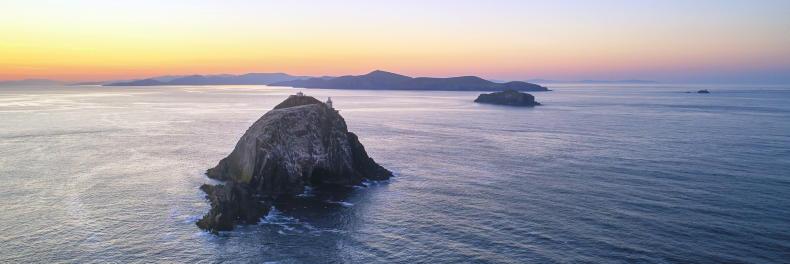



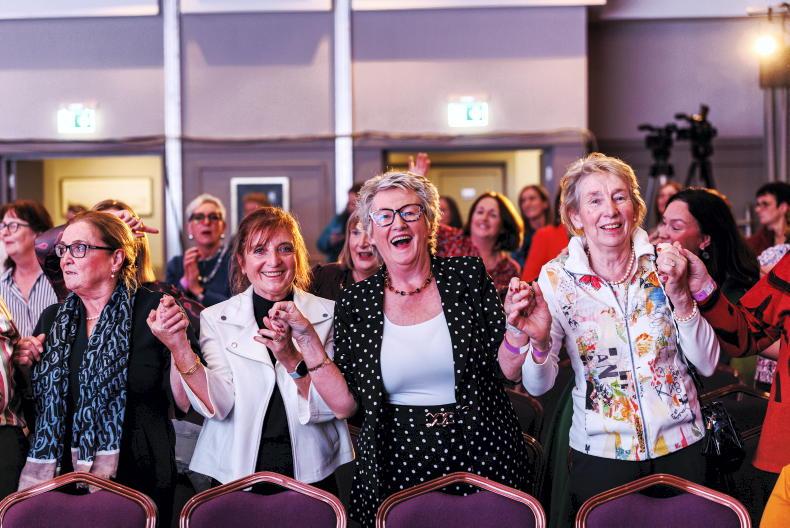
SHARING OPTIONS